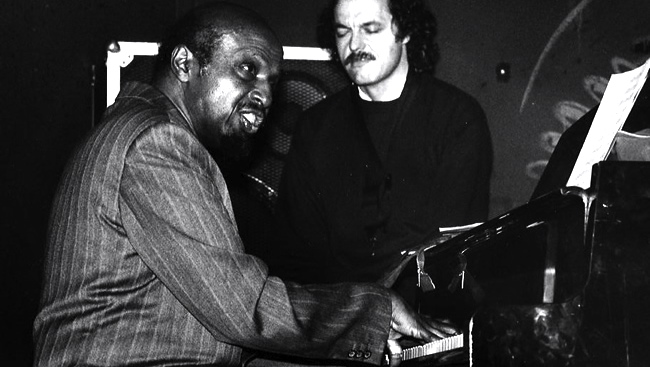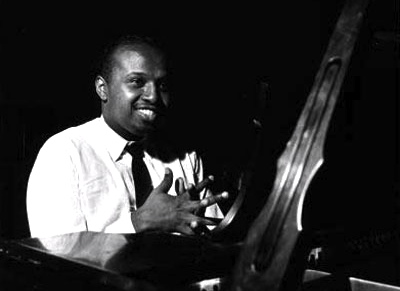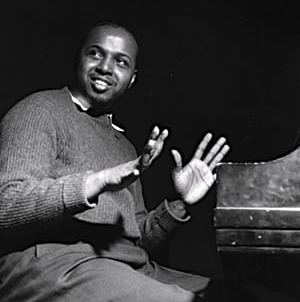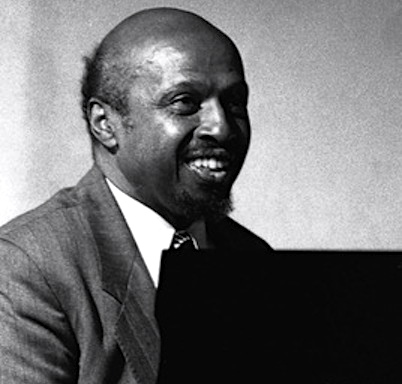
Horace Parlan was born on January 19, 1931 in Pittsburg, Pennsylvannia. As a child, Parlan was stricken with polio, resulting in the partial crippling of his right hand. The handicap, though, has contributed to his development of a particularly “pungent” left-hand chord voicing style, while comping with highly rhythmic phrases with the right.
Much of pianist Horace Parlan’s distinguished jazz life has been marked by an intriguing series of ebbs and flows. At times his artistry has received the attention and praise it deserves, while at others it has been curiously overlooked and neglected. All the more interesting is that amid these sometimes unnerving shifts, Parlan has remained a model of musical consistency.
Just flip through the pages of his accomplished career – between 1952 and 1957 he worked in Washington DC with Sonny Stitt and then spent two years with Charles Mingus’ Jazz Workshop, to his stellar ‘60s recordings for Blue Note, and on to his more recent work with Archie Shepp and Danish bassist Jimmi Pederson – and you’ll undoubtedly be struck by the singularity and cohesiveness of his approach.
Unlike most musicians, who study the fundamentals of their instrument before seeking out a distinctive sound and style, Parlan was compelled to address the piano from a unique direction all along. An early childhood bout with polio left his right hand partially paralyzed, forcing Parlan to compensate by developing a personal style largely reliant on the left -not only for the usual measures of accompaniment, but also to weave melodic phrases and swinging single-note runs.

Armed with this approach, Parlan left his hometown of Pittsburgh in 1957 to try his hand in the greener jazz pastures of New York. Almost immediately, he found a place in the Mingus Jazz Workshop – where he remained until 1959, playing on such seminal recordings as Blues & Roots and Mingus’ Ah Hum.
Between 1960 and 1963, Parlan went on lead a series of potent sessions for Blue Note (thankfully reissued by Mosaic Records as The Complete Blue Note Horace Parlan Sessions) – reinforcing his soulful, rhythmically inventive style, and introducing his equally inspired compositional voice. His tenure with the label also saw him join forces with bassist George Tucker and drummer Al Harewood: a rock-solid rhythm section that quickly became one of the most sought after in jazz.
Parlan played with Booker Ervin in 1960 and 1961, and then in the Eddie “Lockjaw” Davis – Johnny Griffin quintet in 1962. Parlan played with Rahsaan Roland Kirk from 1963 to 1966 and had a strong series of Blue Note recordings in the ’60s.
Then things began to change. “The work situation in New York in the late ‘60s, for me at least, was not optimal,” said the soft-spoken Parlan in a recent phone interview. “I was doing a lot of commercial jobs playing in East Side clubs. I wasn’t all that happy.”

Add to this an increasingly tenuous social climate, along with the continued prominence of drugs on the jazz scene, and Parlan began to consider a move. “I did a Scandinavian tour with the South African singer Miriam Makeba,” recalled Parlan. “In Copenhagen, I visited the old Mantra Club and got to meet a couple of the Danish musicians, among others Niels-Henning Ørsted-Pedersen. I liked the atmosphere of the city, and the people were quite friendly too.”
Finally, in 1972, Parlan decided to try his luck overseas. By that time, Denmark had already established itself as a jazz hub for American ex-pats. Tenormen Dexter Gordon and Ben Webster, trumpet player Idrees Sulieman, and saxophonist Sahib Shihab were all stationed there, and some six months after Parlan relocated, drummer Ed Thigpen landed as well. Work was on the rise, and Parlan was poised.
In the decades that followed, he recorded as both leader and sideman for Denmark’s Steeplechase Records, yielding some of his best music to date. Among these were two acclaimed duet albums with saxophonist Archie Shepp – the second of which, entitled <em>Trouble in Mind</em>, was voted Downbeat’s Album of the Year in 1980. Sadly though, few of the releases saw the light of day in North America – leaving Parlan squarely in the shadows once more.

Then, in 1999, documentarian Don McGlynn approached Parlan in hopes of capturing him on camera. The film and ensuing soundtrack, both entitled Horace Parlan By Horace Parlan, ensnare the pianist on home turf working through a program of engaging and intimate duets with bassist Jimmi Pederson.
And yet despite these morsels of attention, Parlan now finds it harder and harder to pin down regular work. “The year before last, there were some jobs I was able to do because there was government money. Now that money’s gone, and actually a lot of the places I once played have closed. It’s not good for anyone here in terms of activity.”
Compounding this is Parlan’s deteriorating health. Diabetes, along with a near complete loss of vision, make traveling to gigs increasingly difficult. Nevertheless, Parlan continues to play each and every day – delighting his beloved wife Norma with his still formidable chops.
As for his admirers, warmth comes in the hope that this latest ‘ebb’ will soon become ‘flow’. Perhaps even in the form of a long-awaited return to New York? Now that would be an Encore of the highest order.
In 2000, he was the recipient of the Ben Webster Prize given by the Ben Webster Foundation.
